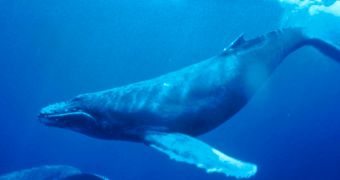A previously-unknown feeding behavior was recently discovered by scientists at the University of New Hampshire, while studying humpback whales. Until now, researchers had no idea that these whales were prone to feeding right off the bottom of the ocean (bottom feeders).
The new finding has important implications for conservation and protection efforts addressed at the sea creatures.
The investigation took place in the Gulf of Maine, where UNH researchers led by expert Colin Ware attached a number of sensors to 52 humpback whales. The study was initially focused on monitoring the animals, since they are endangered in the area.
The instruments relayed a series of measurements back to the team, including the location and speed of each animals. Interestingly, the sensors also displayed the creatures' body orientations. By using these data, scientists were able to determine that the whales fed on the ocean floor via rolling.
In essence, the whales would roll over and over again very close to the ocean floor, gulping up fish right from the bottom. At times, they would miscalculate the distances, and end up ramming the floor. This left numerous scars on their bodies.
This discovery highlights an increased risk of humpback whales becoming ensnared in fishing nets set along the bottom of the ocean. Most often, the animals would engage in this feeding behavior between 10 pm and 4 am. Around 40 percent of the study group fed at night in this manner.
“Humpbacks have not been known as bottom-feeders, yet this is their dominant feeding mode in this region. You've got this prominent species, and until now, nobody knew how they were doing most of their feeding,” Ware explains, quoted by LiveScience.
Details of the research were first published online in the journal Marine Mammal Science, in July 2013. The paper was entitled “Bottom side-roll feeding by humpback whales (Megaptera novaeangliae) in the southern Gulf of Maine, U.S.A.”
The work suggests that new protection and conservation laws may need to be drawn up, where this behavior is taken into account when creating fishing zones that contain lobster traps or gill nets for deep-sea fish.
“The big mystery is we still don't know exactly how they're feeding. We don't know the mechanism,” Ware concludes.

 14 DAY TRIAL //
14 DAY TRIAL //